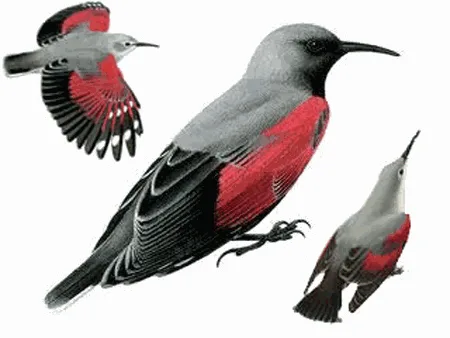
Wallcreeper
[order] PASSERIFORMES | [family] Tichodromidae | [latin] Tichodroma muraria | [UK] Wallcreeper | [FR] Tichodrome echelette | [DE] Mauerlaufer | [ES] Treparriscos | [NL] Rotskruiper
Subspecies
| Genus | Species | subspecies | Breeding Range | Breeding Range 2 | Non Breeding Range |
| Certhia | muraria | ||||
| Tichodroma | muraria | ||||
| Tichodroma | muraria | EU | s Europe to c China | ||
| Tichodroma | muraria | muraria | |||
| Tichodroma | muraria | nepalensis |
Physical charateristics
Medium-sized, colorful, rock-creeping passerine, with long bill and large feet.
Plumage mix of dusky grey, black, and white, with large ‘flashing’ carmine wing-patch, unique in west Palearctic. Distinctive loud call.
Sexes dissimilar, marked seasonal variation in male.
Plumage mix of dusky grey, black, and white, with large ‘flashing’ carmine wing-patch, unique in west Palearctic. Distinctive loud call.
Sexes dissimilar, marked seasonal variation in male.
Listen to the sound of Wallcreeper
[audio:http://www.aviflevoland.nl/sounddb/W/Wallcreeper.mp3]
Copyright remark: Most sounds derived from xeno-canto
| wingspan min.: | 63 | cm | wingspan max.: | 78 | cm |
| size min.: | 30 | cm | size max.: | 41 | cm |
| incubation min.: | 27 | days | incubation max.: | 29 | days |
| fledging min.: | 0 | days | fledging max.: | 29 | days |
| broods: | 1 | eggs min.: | 2 | ||
| eggs max.: | 4 |
Range
Eurasia : South Europe to Central China
Habitat
Breeds in west Palearctic in mountains regions of lower middle latitudes, in rocky, broken, or precipitous terrain, subject to varied weather stresses but normally cool or chilly and often dull and moist. Using bare moist sites with overhanging rock faces, either in the open or in gorges. Limestone preferred to granite, and presence of nest-cavities a limiting factor. Often near torrents, tunnels, caves, moraines, or scree.
Reproduction
Breeding starts June-July in Austria, July-August in Switzerland and mid June to mid July in Caucasus.
Nest site is built in cleft in rock face, behind rock, or in heap of boulders or scree. Site must be inaccessible to mammalian predators, particularly stoat and marten. Entrance passage generally wide enough for any predator to enter. Height can range from base of rock wall to well over 100 m. Rock faces with clumps of vegetation preferred to bare walls. Often in narrow gorge above mountain torrent, and wetness a common feature of nest site.
Nest, commonly two entrances to chamber, often one used as entrance and other as exit. Foundation of moss mixed with lichen, needles of pine, grass, and roots lined with hair, feathers, wool, rootlets, etc.
4-5 eggs are laid, incubation, 18-20 days, by female only.
Nest site is built in cleft in rock face, behind rock, or in heap of boulders or scree. Site must be inaccessible to mammalian predators, particularly stoat and marten. Entrance passage generally wide enough for any predator to enter. Height can range from base of rock wall to well over 100 m. Rock faces with clumps of vegetation preferred to bare walls. Often in narrow gorge above mountain torrent, and wetness a common feature of nest site.
Nest, commonly two entrances to chamber, often one used as entrance and other as exit. Foundation of moss mixed with lichen, needles of pine, grass, and roots lined with hair, feathers, wool, rootlets, etc.
4-5 eggs are laid, incubation, 18-20 days, by female only.
Feeding habits
Small insects and spiders. Prey obtained mainly on rock faces, also among pebbles on banks of streams and below cliffs, occasionally from trees. While foraging, frequently investigates crevices, often disappearing between rocks.
Conservation
This species has an extremely large range, and hence does not approach the thresholds for Vulnerable under the range size criterion (Extent of Occurrence <20,000 km2 combined with a declining or fluctuating range size, habitat extent/quality, or population size and a small number of locations or severe fragmentation). The population trend appears to be stable, and hence the species does not approach the thresholds for Vulnerable under the population trend criterion (>30% decline over ten years or three generations). The population size is very large, and hence does not approach the thresholds for Vulnerable under the population size criterion (<10,000 mature individuals with a continuing decline estimated to be >10% in ten years or three generations, or with a specified population structure). For these reasons the species is evaluated as Least Concern.

Migration
Altitudinal and short-distance migrant; some birds perhaps sedentary; others make longer movements which show regular pattern, though sporadic records furthest from breeding areas are probably attributable to drift; part of population remains within breeding range. Timing of autumn movement is regular, and apparently independent of weather conditions; basically similar throughout range, birds occurring outside breeding areas mostly October-April.
Distribution map

